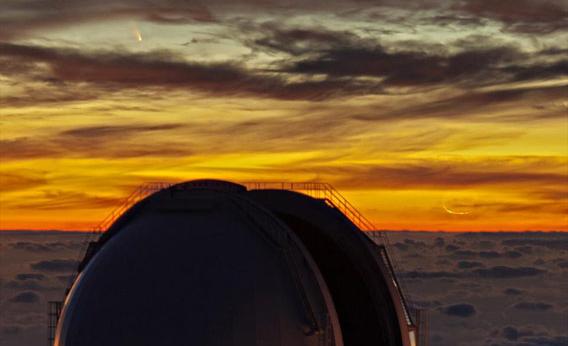Create a free profile to get unlimited access to exclusive videos, sweepstakes, and more!
Go See Comet Pan-STARRS While You Can!

The bright comet Pan-STARRS is putting on quite a show right now. It just moved into the northern skies after a splashy display for those south of the equator, and itâs still quite bright. I went out on Tuesday night and despite the clouds I could easily see it in my binoculars near the setting (and extremely thin) crescent new Moon. The next night, Wednesday Mar. 13, was a bit better. It was very fuzzy in my telescope and actually looked better through binoculars; the comet itself is so fuzzy that the telescope just magnified the blurriness. Once I knew where to look using the binocs it was pretty easy to spot with just my eyes, even though it was low and there was haze in the sky.
I mentioned this on Twitter, and my feed lit up with people posting pictures they had taken or had seen. The picture at the top of this post is my favorite; taken by my friend and astrophotographer Babak Tafreshi, it shows the Moon and the comet setting behind the William Herschel Telescope dome on La Palma in the Canary Islands. At an elevation of over 2300 meters (1.4 miles), clouds form below the observatory, so there are usually clear skies there. Iâve visited this observatory and itâs magnificent even without the celestial visitor seen here.
You donât need to be a professional astrophotographer to get great shots, though. My pseudonymous friend Boo took the shot above using just a camera (Canon EOS 40D) and a 250mm lens. I shrank it considerably to fit the blog; hereâs the much higher-res picture. Itâs beautiful, and you can really see the tail of the comet and Earthshine on the Moon; the dark part of the Moon lit by reflected light from Earth.
Next up is a nice close-up of the comet by Adam Block (whose images have graced this blog many times before). He didnât use a telescope though! This is once again a Canon 40D, but with a 300 mm lens. The detail in the tail is amazing; you can see the thin ion tail flying straight back from the comet and the much broader dust tail fanning out. He also got a lovely wide-field shot of the comet and the Moon, too.
Finally, this next image is a jaw-dropper: Itâs from the sun-observing STEREO B spacecraftâI wrote quite a bit about this the other dayâand with some digital processing the image shows multiple rays in the tail streaking away from the comet. STEREO saw something very similar to this in comet McNaught back in 2007, and trust me, you want to see that!
Pan-STARRS should be visible for the next couple of weeks, moving north but getting fainter as it does so. It passed the Sun on March 10, and as it moves away the illumination drops, so it dims. As you can see in the diagram below, its orbit is nearly perpendicular to Earthâs (the dark blue line is when it was south of the Earthâs orbital plane, and light blue is north). The path itâs taking is nearly face-on to us, so it never gets any closer than it is now, and itâs moving nearly straight up, out of the Earthâs orbital plane, so the distance to it is increasing rapidly. By April it will have faded considerably, and may dim to below naked eye visibility by mid-April.
So go out and see it while you can! You hardly even need a map (though hereâs one from Sky and Telescope and another at Astronomy magazine that will help). It should be visible about a half hour after sunset (earlier if you have binoculars) to the west. Iâll note that for folks with decent binoculars and/or cameras, the planet Uranus is pretty close to Pan-STARRS as well. Dean Ketelsen was able to see it in the pictures he took on Mar. 12!
And if you want to see even more pictures, point your browser to SpaceWeather.com and UniverseToday, which have amazing pictures for show and tell, too.
And donât fret: If you miss this one, Comet ISON is coming this fallâ¦


























